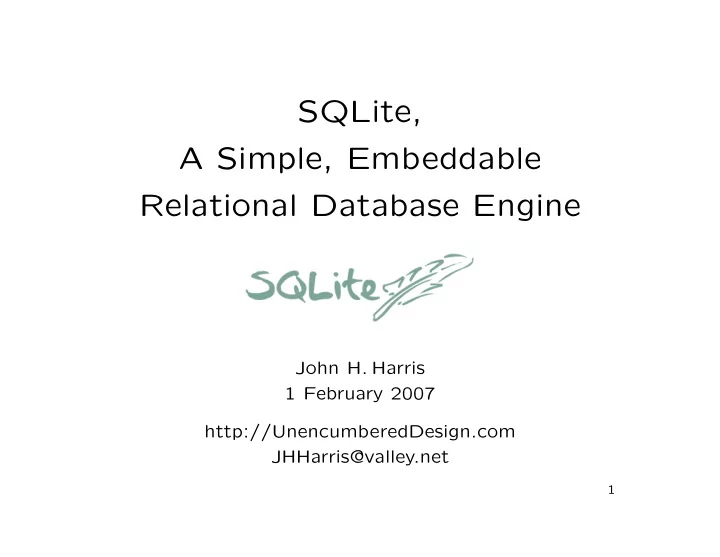

SQLite, A Simple, Embeddable Relational Database Engine John H. Harris 1 February 2007 http://UnencumberedDesign.com JHHarris@valley.net 1
Overview SQLite Characteristics SQLite for Systems SQLite in Applications Advanced Features 2
SQLite Characteristics History May 2000. D. Richard Hipp releases version 1.0 alpha. Sep 2001. Version 2.0. Oct 2003. I discover SQLite (2.8.7). Sep 2004. Stable version 3.0.7 released. Dec 2005. Last version 2 release: 2.8.17. Oct 2006. Added full text search in version 3.3.7. 3
SQLite Features • Small. ( < 250 kB). No dependencies. • Simple. No administrative overhead. Untyped. Single data file with a portable format. • True relational database. Rich subset of SQL92. ACID transactions. • APIs in C, C++, Tcl. Many others (Python, ODBC, Java, Perl, PHP, etc.) available from second sources. • Portable. Widely used, stable, solid. • High performance. Fast. Large databases (10 41 bytes). • Open source (public domain). 4
SQLite Limitations • No access control (i.e., embeddable ). • Foreign key constants must be implemented with triggers. • No type checking. • No scaled integers. No date and time types. • No nested transactions. • Other minor SQL limitations. 5
Where Does SQLite Fit In? MySQL. Very high-performance server. Fashionable. PostgreSQL. High-performance sever. Full SQL implementa- tion. Safer data. Better ad hoc queries. Firebird. Simpler, smaller server or bigger, fancier embeddable db. Limited APIs. SQLite. Small, simple, embeddable (no access control), but true relational model, SQL. Berkeley DB. Embeddable. Transaction-based, but not rela- tional (no SQL). Rumored to be vulnerable to power failures. Metakit. Embeddable. Not relational (no SQL). No transac- tions. 6
How Fast? In tests of SQLite 2.7.6 versus PostgreSQL 7.1.3 and MySQL 3.23.41. • SQLite was significantly faster (as much as 10 or 20 × ) than the default PostgreSQL for most common operations. • SQLite was often faster (sometimes more than 2 × ) than MySQL for most common operations. • SQLite did not execute create index or drop table as fast as the others. • SQLite works best with operations grouped into a single transaction. 7
Who Uses SQLite? America On Line, Apple Computer (OS X, Safari, Mail, etc.), Cisco Systems?, Google?, Mozilla, Palm OS, PHP 5, Sun Microsystems (Solaris), Trolltech (KDE), Unencum- bered Design. 8
SQLite for Systems The Missing UNIX Tool • High performance. • Safer than UNIX tools for related tables. • Great way to learn SQL. • System databases are more accessible. 9
Getting Started From BASH, sqlite3 my.db From the SQLite shell prompt: create table poot (a integer, b text); insert into poot values (1, ’I did it.’); select * from poot; .exit 10
Investigating a SQLite DB File Use the sqlite3 admin tool to discover the schema: select * from sqlite_master; You get a result set: Type of object ( table , index , view ). type Name of object. name Object’s associated table. table_name Object’s B-tree root page. root_page Object’s defining SQL code. sql 11
Troubleshooting a SQLite DB File Use the sqlite analyzer program to get memory use stats: sqlite_analyzer dbFile Use the vacuum command to collect garbage. 12
Attaching to a System DB File Sqlite can join multiple db files: attach database blort.db ; Then join tables across databases: select uid, name, address from blort.users, main.users where blort.users.id = uid; 13
SQLite in Applications Why Embed a Database? • You need a database. • A simple back end for a web server. • Improve performance for client-server applications. • Persistent data. No need to “save.” • Implement infinite undo, redo. • Transactions protect data from corruption. 14
Why a Relational Database? • Normalized data structures are stable. • Normalized data structures minimize redundancy, and hence, bugs. • Simple data integrity protects data from GUI bugs. • Simple, declarative data integrity code protects data from GUI bugs. • Ad hoc queries are a powerful diagnostic tool. 15
Getting Started, from Tcl From tclsh, package require sqlite3 sqlite3 db my.db db eval { create table poot (a integer, b text); insert into poot values (1, ’I did it.’) } db eval { select * from poot } exit 16
Advanced Features Full Text Searches. Like Google searches. Define Functions with Tcl. Database in RAM. Fast. 17
Full Text Searches create virtual table photos using fts1 ( id, content ); Insert your data, then select * from photos where content match ’fox owl’; select * from photos where content match ’fox OR moose’; select * from photos where content match ’"bird dog"’; 18
Defining Functions in Tcl To convert data formats: proc iso8601 { t } { clock format $t -format %Y-%m-%dT%T } db function iDate iso8601 db eval { select iDate(modified) } To executing data as code: db function tcl eval db eval { select tcl(’set x 5’) } 19
Database in RAM Just leave off the file name. + It’s fast—no seeking. – Data must me small enough to fit in RAM. – Not persistent. 20
Resources • SQLite web site, http://www.sqlite.org/ • Michael Owens. The Definitive Guide to SQLite . 2006. Berkeley CA: Apress. • Any introductory SQL book. • D. Richard Hipp, HWACI Applied Software Research, (704) 948 4565, DRH@hwaci.com. • John H. Harris, Unencumbered Design, (802) 649 8130, JHHarris@valley.net. 21
rev 0a 22
Recommend
More recommend